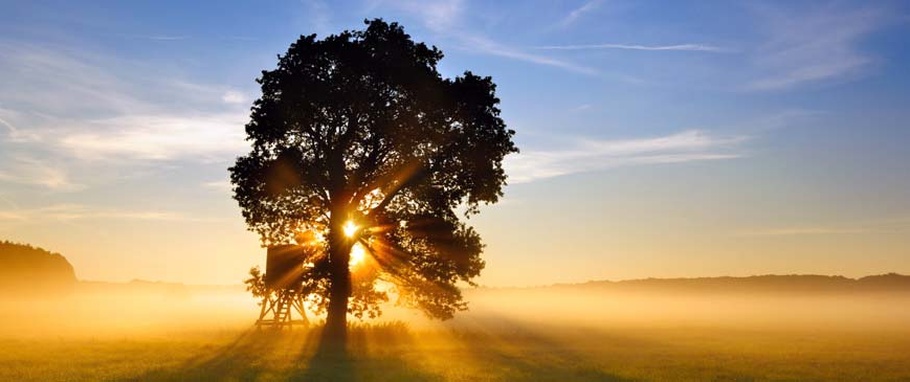

Oak is a beautiful, versatile and symbolic material. Oak framed buildings feel somehow alive with atmosphere and warmth – they can be rich, rustic and charming; or light, innovative and spacious when combined with modern materials and architectural ideas.
Oakmasters specialise in working with this unique timber. As a family company, we've been providing international, commercial and private customers with luxury oak products for over 30 years, having worked on prestigious restoration projects with the Mary Rose Trust and Hampton Court Palace amongst others.
Oak tress grow in all moderate climate areas, but are particularly abundant in the UK and Europe. English oak trees are slightly shorter and more robust, while French oak trees tend to be longer and straight. Whilst we can source English oak for our clients, the majority of our raw materials come from France, as French oak is better suited for oak framed buildings and oak roof trusses.
Green oak is one of the most sustainable building materials around. It is relatively local, keeping transport to a minimum. There are 3 sets of people between an oak forest and you: the forest workers, the sawmills and us. Oak is cut to your bespoke project sizes directly at the sawmill and shipped to us on a truck. There is no drying, chemical processing or excessive haulage causing contributions to CO2 emissions.
Oak forests are well managed - European forest management is first class, ensuring tree population grows, rather than diminishes. Oak trees are grown as a crop, akin to many other agricultural crops and felled sections of the forest are immediately replanted, providing the young trees with adequate space and light to grow. As the young trees grow, they capture CO2 more efficiently than old trees, locking it in forever.
We source our oak from sustainably managed sources both in the UK and Europe. You can rest assured that the oak you buy from us has not contributed towards deforestation.
In short, yes. All green oak frames spend the first few years of their lives shrinking and developing cracks. It's part of their natural charm. However, specialist oak frame designers take this into consideration and allow for shrinking in the design of the oak frame. Our carpenters check every oak beam for defects before using it in the frame production and reject any items with excessive cracks or faults. Cracks that develop after the frame has been manufactured are cosmetic only and will have no effect on the structural integrity of the oak frame.
Shrinking happens across the grain, which means there is no risk of oak beams 'dropping out' from the frame. They will always retain their length. You might find that after a few years, small gaps appear between the beams and the plaster, or around the joints, but this is cosmetic only and happens with all green oak frames.
Oak is one of the most durable materials you will find, with built in natural defences against pests. Essentially, it is maintenance-free, if you are happy for oak to change colour to silver over time, when exposed to sun and rain. There are treatments such as Sikkens or wax oils you can use to help maintain the original colour for longer. It is, however a labour of love and requires ongoing commitment and regular maintenance. We recommend following manufacturers' instructions for each type of product. Internally, natural oak will age very gracefully, gaining that lovely honey hue we all know and love.
Green oak
We use green oak for most framing applications. It is recently felled and sawn, often up to a year old depending on the season, as it is preferable to fell oak at certain times of the year. Green oak has a high moisture content and it is normal and expected that the oak will shrink and move in the first few years of its life, and natural splits known as shakes will form over time. See Green Oak in Eco-building for more information.
Air dried oak
We use air dried oak in various applications like external cladding or capping for our encapsulated glazing system. Air dried oak is ideal for use in situations where the wood needs to be seasoned in order to fit its environment. Air dried oak is left in naturally ventilated drying sheds for long periods of time to allow the moisture content to reduce down to a stable level. This process is usually only used for plank shaped sections of oak as it takes many years for thicker pieces to dry. The rule of thumb for air dried oak is 1 year per inch of thickness drying time, plus a year to dry down to a stable 20% moisture content.
Kiln dried oak
Kiln dried oak is mostly in used precise joinery products such as specialist beam covers, doors, windows etc. As green oak dries out over a number of years in a natural environment cracks and splits can sometimes occur on the surface. This is fine for an oak frame building, however, movement like this is not acceptable in joinery products, which require high levels of precision. The use of a kiln speeds up the drying period in a controlled environment. The production of kiln dried oak is of course more energy and time intensive and therefore it increases the end cost of the product.